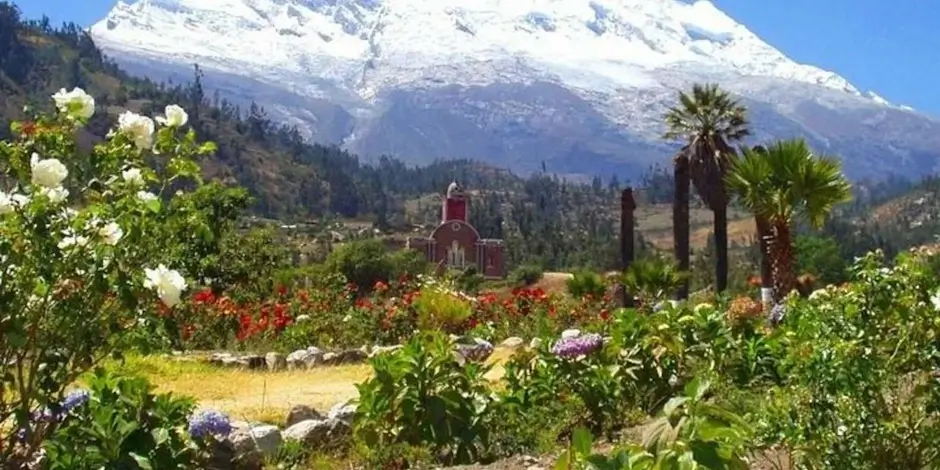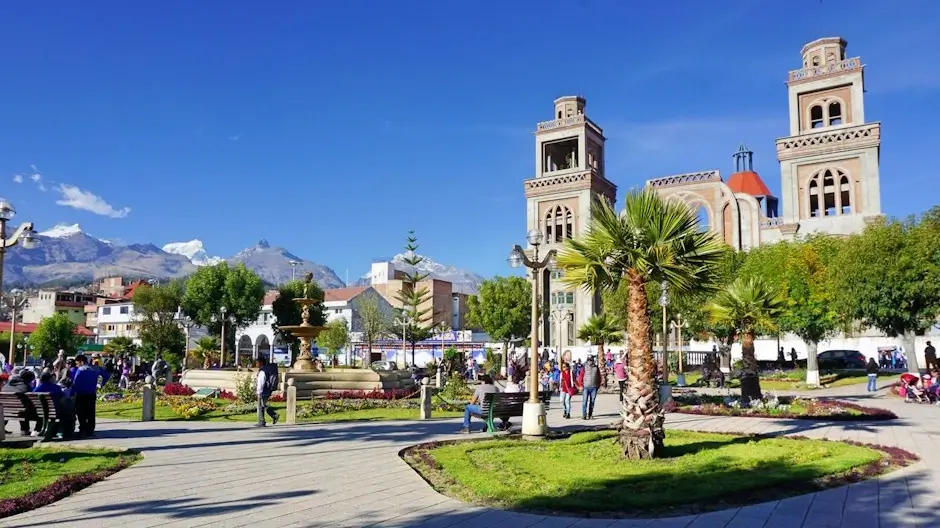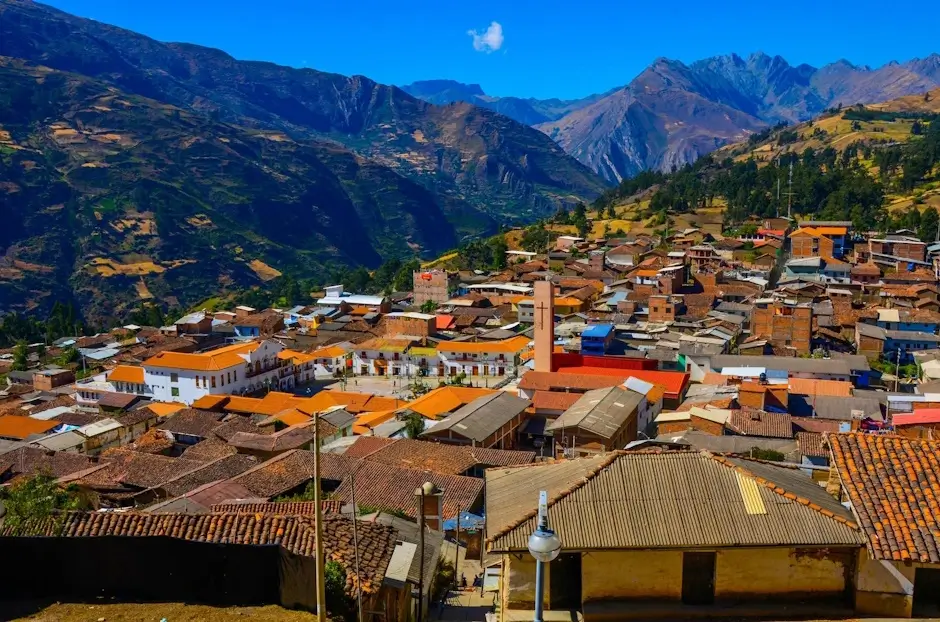Exploring the Beauty of Ancash
The Ancash region Peru,Nestled within the rugged landscapes of the Andes Mountains in Peru, the region of Ancash stands as a testament to nature’s awe-inspiring beauty and the rich cultural tapestry woven by its inhabitants. This enchanting destination offers a diverse array of attractions, from majestic snow-capped peaks to ancient archaeological wonders, making it a must-visit for travelers seeking a blend of adventure and history.
- Discover the Wonders of Peru: with the Tour Perú Machu Picchu Nazca 15 Days
- Discover the Best of Perú: with the Tour Perú Amazon Nazca Machu Picchu 20 Days
- Travel Package to Peru Tour in Lima, Paracas, Ballestas, Nazca Lines, Colca Canyon 22 Days
The Cordillera Blanca and Huaraz: The Gateway to the Andes
Tucked away in the Peruvian Andes, the Cordillera Blanca is a breathtaking paradise of snow-capped peaks, turquoise lagoons, and dramatic alpine landscapes. At the heart of this natural wonder lies Huaraz, a vibrant mountain city that serves as the gateway to one of the most spectacular regions in South America. For adventure seekers, nature lovers, and cultural explorers alike, Huaraz and the Cordillera Blanca promise an unforgettable journey into the soul of the Andes.
Huaraz: Base Camp for Adventure
Located at an altitude of over 3,000 meters (9,800 feet), Huaraz is the capital of the Áncash region and the starting point for most expeditions into the Cordillera Blanca. Despite its rugged mountain setting, the city is lively and welcoming, offering a range of accommodations, local restaurants, and gear shops for trekkers and climbers. It’s a place where modern life meets traditional Andean culture—where you can enjoy a steaming bowl of quinoa soup while watching locals in colorful dress pass by on their way to the market.
Cordillera Blanca: A Crown of the Andes
The Cordillera Blanca, or “White Range,” is the highest tropical mountain range in the world, home to more than 30 peaks soaring above 6,000 meters (19,600 feet), including Peru’s tallest mountain, Huascarán (6,768 meters / 22,205 feet). With its jagged peaks, icy glaciers, and dramatic valleys, the range is often referred to as the crown jewel of the Andes.
Protected within the Huascarán National Park, a UNESCO Biosphere Reserve, the region is a sanctuary for high-altitude flora and fauna. Trekkers may encounter condors soaring overhead, or rare species such as the spectacled bear. The scenery here is nothing short of extraordinary.
Unforgettable Treks and Adventures
From Huaraz, travelers can embark on some of the most famous treks in South America. The Santa Cruz Trek is a four-day journey through glacial valleys, high passes, and remote villages—a favorite among experienced hikers for its stunning beauty and moderate difficulty.
Another iconic experience is the Laguna 69 hike, a challenging day trip that rewards adventurers with the sight of an intensely blue glacial lake framed by snow-covered peaks. It’s a photographer’s dream and a spiritual retreat all in one.
For seasoned climbers, peaks like Alpamayo—once named the most beautiful mountain in the world—offer technical ascents and unforgettable summits.
Culture, Tradition, and Local Warmth
While the natural landscapes are a major draw, the cultural richness of the area is equally captivating. The villages surrounding Huaraz are inhabited by Quechua-speaking communities who maintain ancient traditions in agriculture, weaving, and mountain worship. Travelers often have the chance to join in local festivals, taste Andean cuisine, or visit artisan markets where traditional crafts are sold.
When to Visit
The best time to explore the Cordillera Blanca is during the dry season, from May to September, when the skies are clear and the weather is ideal for trekking and climbing. Even during the busiest months, the trails remain relatively uncrowded compared to other global trekking destinations.
The Cordillera Blanca and Huascarán National Park: A Natural Wonder of the Peruvian Andes
Rising majestically in northern Peru, the Cordillera Blanca is the highest tropical mountain range in the world and one of the most breathtaking natural treasures in South America. Stretching over 180 kilometers through the region of Áncash, this range is home to towering snow-capped peaks, shimmering turquoise lagoons, and lush glacial valleys. At its heart lies the Huascarán National Park, a protected area that safeguards the region’s extraordinary biodiversity and cultural heritage.
Together, the Cordillera Blanca and Huascarán National Park form a paradise for adventurers, nature lovers, and anyone seeking a deep connection with the Andes.
A Kingdom of Snow and Sky
The Cordillera Blanca, meaning “White Range,” earns its name from its permanent snow cover and dazzling white peaks. More than 30 mountains rise above 6,000 meters (19,685 feet), including Huascarán, the tallest mountain in Peru at 6,768 meters (22,205 feet). These dramatic summits tower above alpine lakes, winding trails, and deep ravines, creating a landscape that is both awe-inspiring and serene.
This region is not only a mountaineer’s dream—with challenging climbs like Alpamayo, Chopicalqui, and Tocllaraju—but also a hiker’s paradise, offering world-class trekking routes for all experience levels.
Huascarán National Park: A Sanctuary for Life
Established in 1975 and recognized by UNESCO as a Biosphere Reserve and World Heritage Site, Huascarán National Park protects more than 3,400 square kilometers of the Cordillera Blanca. Its purpose: to conserve the area’s ecosystems, glaciers, flora, fauna, and archaeological remains.
The park is a refuge for many unique species, including the spectacled bear, Andean condor, puma, and Andean fox, as well as high-altitude plant species like the Puya raimondii, the largest bromeliad in the world. It’s a place where nature thrives in its purest form, high above the rest of the world.
Treks of a Lifetime
Huascarán National Park offers some of the most beautiful and accessible trekking experiences in the Andes:
- Laguna 69: A challenging day hike that rewards you with views of one of the most stunning glacial lakes in the region, known for its intense turquoise color.
- Santa Cruz Trek: A four-day adventure that takes you through remote valleys, beneath towering peaks, and across high mountain passes, often cited as one of the best treks in South America.
- Llanganuco Valley: Home to the famous Llanganuco Lakes, Chinancocha and Orconcocha, this area offers scenic walks, camping spots, and opportunities for wildlife observation.
Whether you’re a beginner or an expert, the park offers something for everyone—each trail revealing new layers of natural beauty and spiritual tranquility.
A Landscape Rich in Culture and History
The Cordillera Blanca is not only a natural wonder but also a region deeply rooted in Andean tradition. Many communities within and around Huascarán National Park still speak Quechua and preserve ancient customs tied to the mountains, which are considered sacred. Archaeological sites such as Chavín de Huántar reveal the long-standing relationship between humans and these highlands, dating back thousands of years.
Travelers often encounter local shepherds, traditional festivals, and handmade textiles that reflect the culture’s enduring spirit and respect for nature.
Visiting Responsibly
Due to climate change, the glaciers of the Cordillera Blanca are retreating at an alarming rate. Visitors are encouraged to explore responsibly—respecting local communities, minimizing environmental impact, and supporting sustainable tourism initiatives that help preserve this fragile ecosystem for future generations.
Cordillera Blanca: Living Culture and Archaeology in the Heart of the Andes
Beyond its towering peaks and breathtaking landscapes, the Cordillera Blanca in Peru holds a deep and vibrant cultural heritage. This majestic region is not only a natural wonder, but also a living museum of ancient traditions and archaeological treasures. From pre-Inca civilizations to modern-day Quechua communities, the Cordillera Blanca offers a unique opportunity to explore the cultural and spiritual essence of the Andes.
Ancestral Roots in the Highlands
Long before the rise of the Inca Empire, the highlands of the Cordillera Blanca were home to sophisticated pre-Columbian cultures. One of the most prominent was the Chavín culture (circa 1200–200 B.C.), whose ceremonial center, Chavín de Huántar, still stands as a powerful symbol of early Andean spirituality and innovation.
Located on the eastern slopes of the Cordillera Blanca, this UNESCO World Heritage Site features a complex of temples, underground galleries, stone carvings, and the famous Lanzón, a sacred monolithic idol. The Chavín people developed advanced knowledge of architecture, astronomy, and ceremonial rituals—much of which influenced later Andean civilizations.
Sacred Mountains and Andean Cosmology
In the Andean worldview, the mountains are not just landforms—they are Apus, sacred spirits that protect the people and the land. The Cordillera Blanca, with its awe-inspiring peaks like Huascarán, Alpamayo, and Huandoy, continues to be revered by local communities as powerful spiritual entities.
Even today, rituals such as pago a la tierra (offering to Mother Earth) are practiced to give thanks to Pachamama and the Apus. These ceremonies blend ancient beliefs with Catholic influences, reflecting a rich cultural syncretism that has endured through centuries of change.
Quechua Communities and Living Traditions
The valleys and villages nestled in the Cordillera Blanca are home to Quechua-speaking communities who preserve ancestral customs in their daily lives. Agriculture, textile weaving, and traditional medicine are deeply rooted in knowledge passed down through generations.
Travelers who visit these communities often witness colorful festivals, traditional clothing, and age-old practices such as weaving with natural dyes, music with Andean instruments, and cooking over open flames using techniques unchanged for centuries. Hospitality is a central value, and visitors are often welcomed into homes with warm smiles and steaming cups of coca tea.
A Journey Through Time
Exploring the Cordillera Blanca is like walking through layers of history. In addition to Chavín de Huántar, the region holds other lesser-known archaeological sites such as Willkawayin, a Wari-era complex, and Honcopampa, where ancient tombs and petroglyphs can still be found amid the mountainous landscape.
Local legends and oral histories further enrich the experience, as elders share stories about mystical lakes, protective spirits, and heroic ancestors who shaped the region’s identity.
Cultural Tourism and Sustainable Preservation
More and more visitors are discovering the value of cultural tourism—an approach that allows travelers to connect with local people while contributing to the preservation of traditions. Community-based tourism initiatives in the Cordillera Blanca offer immersive experiences such as:
- Participating in traditional farming and weaving
- Learning about Andean medicinal plants
- Joining in mountain pilgrimages and local festivals
By choosing these experiences, travelers not only gain deeper insight into the Andes, but also help support rural economies and the continuation of cultural heritage.
- Embark on a Journey of Ancient Traditions: The Inti Raymi Tour in Cusco 4 Days
- Discover the Wonders of Peru with the Tour Perú Machu Picchu 5 Days
- Discover Peru with the City Tour Sacred Valley Machu Picchu 4 Days
- Explore the Wonders of Cusco with City Tour and Machu Picchu3 Days
Cordillera Blanca: Year-Round Adventure in the Heart of the Andes
For those who seek adventure in its purest form, the Cordillera Blanca in northern Peru is a dream destination. With its towering peaks, crystal-clear lakes, and vast alpine valleys, this majestic mountain range offers thrilling outdoor experiences all year long. Whether you’re a seasoned mountaineer, an avid trekker, or a nature enthusiast looking for scenic escapes, the Cordillera Blanca delivers adventure in every season.
A Playground for Outdoor Enthusiasts
The Cordillera Blanca is the highest tropical mountain range in the world, home to more than 30 peaks rising above 6,000 meters (19,600 feet), including Huascarán, the tallest mountain in Peru. Its varied terrain makes it ideal for a wide range of outdoor activities—from hiking and mountain climbing to biking and ice climbing.
In the surrounding areas and within Huascarán National Park, visitors find well-marked trails, glacier-fed lakes, and remote high-altitude campsites. The region’s accessibility and relatively mild climate make it a year-round playground for explorers.
Best Time to Visit: May to September
The dry season, from May to September, is the most popular time for adventure travel in the Cordillera Blanca. During these months, the weather is typically sunny and stable—perfect for trekking, camping, and mountaineering.
Some of the highlights during this season include:
- The Santa Cruz Trek: A classic 4-day hike offering panoramic views of snow-capped peaks, green valleys, and glacial rivers.
- Laguna 69: A challenging but rewarding day hike to one of the most stunning alpine lakes in South America.
- Climbing Alpamayo or Huascarán: For experienced climbers, these technical ascents are bucket-list experiences.
- Mountain biking: Trails near Huaraz and Caraz provide adrenaline-pumping rides through dramatic landscapes.
Off-Season Wonders: October to April
While the wet season (October to April) brings occasional rain and cloudy skies, it doesn’t mean the adventure stops. During this time, the Cordillera Blanca is quieter, greener, and full of life. Waterfalls are fuller, flowers bloom across the valleys, and the air is crisp and fresh.
Though multi-day treks may be more limited due to weather, there are still plenty of experiences to enjoy:
- Short hikes and day trips: Explore lower-altitude trails that remain accessible, such as the Llanganuco Lakes or easy hikes to nearby villages.
- Cultural encounters: Visit Quechua communities to learn traditional weaving, farming techniques, and local cuisine.
- Hot springs and wellness: Relax in natural hot springs like Monterrey near Huaraz, ideal for unwinding after a day of exploration.
Adventure for All Skill Levels
One of the Cordillera Blanca’s greatest strengths is its accessibility. Whether you’re a first-time hiker or an experienced mountaineer, there’s an adventure waiting for you:
- Beginner-friendly: Scenic walks, moderate treks, and guided nature tours.
- Intermediate: Multi-day treks like Santa Cruz or Quebrada Quilcayhuanca.
- Advanced: High-altitude climbs, ice climbs, and technical mountaineering routes.
Certified local guides and support services in towns like Huaraz make planning and executing your trip safe and enriching.
A Destination for Mind, Body, and Spirit
Adventure in the Cordillera Blanca isn’t just physical—it’s also deeply spiritual. The serene beauty of the mountains, the sound of the wind through the high valleys, and the sight of towering Apus (sacred peaks) create a powerful connection with nature. Many travelers describe their journey here as transformative—a chance to disconnect from the modern world and reconnect with themselves.
Cordillera Blanca: Authentic Communities and Andean Hospitality
The Cordillera Blanca is renowned for its snow-capped peaks, turquoise lakes, and thrilling treks—but beyond the natural wonders lies another treasure: its people. Scattered across the valleys and foothills of this majestic mountain range are authentic Andean communities that preserve centuries-old traditions and offer travelers a unique opportunity to connect with the living culture of the Peruvian highlands.
Visiting the Cordillera Blanca is not just a journey through nature—it’s a cultural immersion into the warmth, resilience, and hospitality of the Andean world.
Quechua Heritage in Everyday Life
Many of the villages surrounding Huaraz and nestled deep in the valleys of the Cordillera Blanca are inhabited by Quechua-speaking communities. These are descendants of ancient Andean civilizations who continue to live in harmony with their environment, practicing traditional agriculture, weaving, and spiritual rituals.
Here, culture is not displayed—it is lived. From the colorful garments woven by hand to the songs sung in the fields, every aspect of daily life reflects a deep connection to heritage, nature, and ancestral wisdom.
A Warm Welcome in the Highlands
The concept of “ayni”—a Quechua word meaning reciprocity—is a guiding principle of Andean life. Visitors often find themselves welcomed like family, invited into homes to share meals, stories, and traditions. The hospitality is genuine and heartfelt, rooted in the belief that every guest is a blessing.
Whether you’re staying in a rustic mountain homestay or simply passing through a village, you’ll be touched by the kindness and generosity of the people. A cup of hot coca tea, a handmade bracelet, or a smile from a local elder can become lasting memories of human connection.
Traditional Festivals and Celebrations
Throughout the year, the communities of the Cordillera Blanca celebrate vibrant festivals that blend pre-Hispanic traditions with Catholic influences. These festivities are rich with music, dance, colorful costumes, and spiritual rituals that honor the mountains, the harvest, and the cycles of life.
Travelers lucky enough to witness celebrations like the Señor de la Soledad in Huaraz or local patron saint festivals in smaller villages will experience the joy, devotion, and energy of Andean culture in its most expressive form.
Community-Based Tourism: Travel with Purpose
In recent years, community-based tourism initiatives have flourished in the Cordillera Blanca, offering travelers the chance to engage more deeply with local life while supporting sustainable development.
These experiences may include:
- Staying with a local family in a traditional Quechua home
- Learning to weave textiles using natural dyes and ancestral techniques
- Participating in farming activities or cooking traditional Andean meals
- Joining in music, dance, and storytelling around a fire
Such tourism benefits not only the traveler but also the host communities, helping preserve cultural identity and generate income in remote areas.
A Cultural Legacy in the Shadow of the Peaks
While many visitors come to the Cordillera Blanca for its dramatic landscapes, those who take the time to engage with its people often leave with a deeper, more meaningful experience. The combination of majestic nature and rich cultural interaction creates a powerful and transformative journey—one that remains long after the treks are over.
The Cordillera Blanca and Huaraz are much more than just a destination—they are a transformative experience. Whether you’re trekking through high mountain passes, admiring glacial lakes, or connecting with the ancient cultures of the Andes, you’ll find that this part of Peru has a way of touching your spirit. For those who seek adventure, inspiration, and authentic connection with nature and people, Huaraz truly is the gateway to the Andes.
- Eplore Peru: From Vibrant Lima to Mystical Machu Picchu and Majestic Lake Titicaca 8 Days
- Perú Travel with Tour Lima Cusco Machu Picchu Lake Titicaca 7 Days
- Explore the Wonders of Cusco with City Tour and Machu Picchu 3 Days
- Explore Peru with the Lima Cusco Machu Picchu Huayna Picchu Tour 6 Days
For more information and to book your trip, contact us on WhatsApp. Follow us on Instagram for the latest updates and travel inspiration.
CONTACT US:
We are a Travel Agency specialized in tourist packages, if you need any information, do not hesitate to write to us.
We offer tours in Peru and Bolivia.




